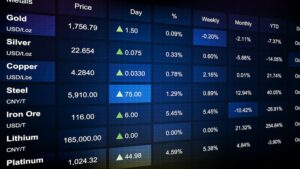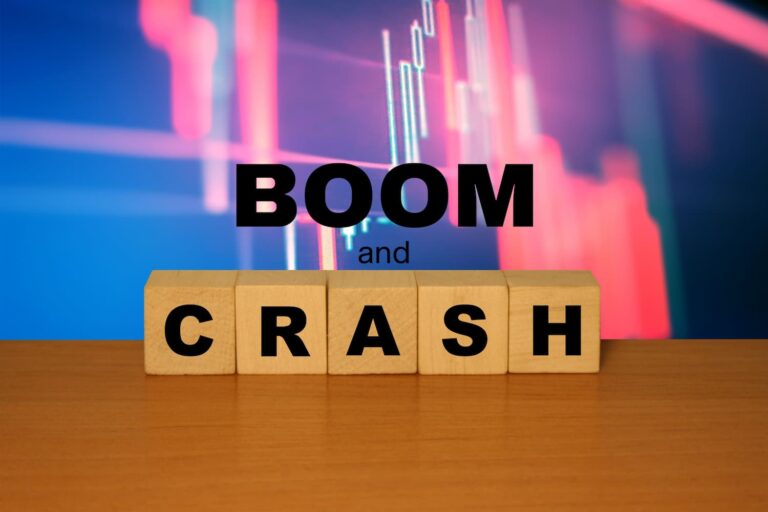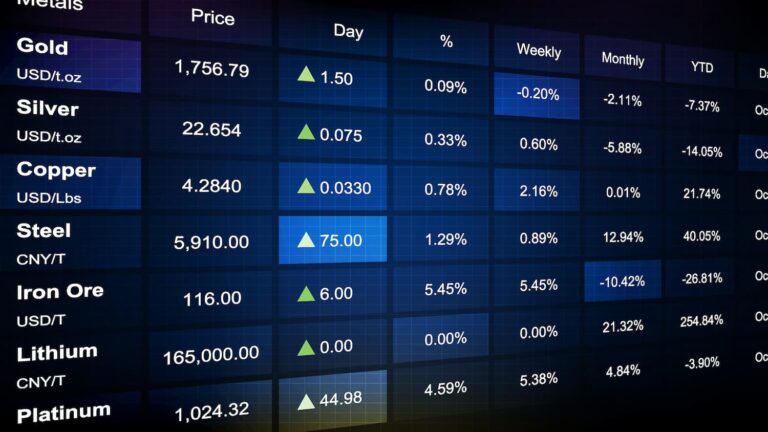If your aim is to become a successful trader, it is important to understand (and implement your understanding of) key financial concepts when choosing your trading strategy. Indices (sing. Index) are a widely used concept in the world of trading, so here provide you with an accessible but thorough introduction to the concept of indices.
What are indices?
Indices are a way of tracking the performance of a collection of assets in a way that is standardised and easy to understand. Indices typically use a subset of assets in an attempt to represent a specific area of financial markets (e.g. the S&P Dow Jones Consumer Staples Select Sector Index) but can also be used to attempt to represent broader markets (e.g. Standard & Poor’s 500 Index). A general index formula is given below:

Where the weighting of which is to be determined. This formula may not be clear now as it is very general, but as we go into more detail on some examples below, it should become more clear to you. In most cases, the variable of interest will likely be the market capitalisation of a company, with the asset being the company valuation.
Indices are used as benchmarks for the performance of portfolios and individual stocks in comparison to the group of assets that they belong to. This is often used by investment funds to show investors how profitable investing in the fund may be compared to investing in an index fund. It is worth noting that you cannot invest in an index; instead, you must invest in an index fund. An index fund is a fund that uses “indexing” which is a passive form of investing (i.e. limits the amount of buying and spending) in which the fund manager attempts to match the components of an index.

Common financial market indices
There are many types of financial market indices. By far, the most common type of index is a stock index but indices can be used to measure the performance of other financial assets such as bonds (e.g. Bloomberg Barclays US Treasury Index) and commodities (Standard & Poor’s GCSI Index). Furthermore, although we will not cover this in detail today, indices can be used to measure the performance of other financial data such as output, inflation, and so on.
Stock indices
Due to being the most popular type of indices, we will go into a bit more detail about stock indices and also to go into detail about some especially important stock indices. A stock index is an index that measures the performance of a stock market or a subset of a stock market. Well-known stock indices include the S&P 500 in the US and the FTSE 100 in the UK.

The S&P 500 is an index with the top 500 companies in the US stock market. The top 500 is decided primarily by market capitalisation, but other factors are included, such as liquidity, trading history, and financial viability. The S&P 500 makes up 80% of the total value of the US stock market and is a good indicator of the performance of the US economy.
The FTSE 100, similarly to the S&P 500, is an index with the top 100 companies listed on the London Stock Exchange. The top 100 is again decided by market capitalisation, and as is the slightly smaller size of the London Stock Exchange, encompasses 80% of the stock exchange’s market capitalisation, and so is also a good indicator for the performance of the UK economy.
As mentioned above, stock indices can be used as a good indicator of the strength of particular economies, sectors, and markets. Therefore, if you are interested in the performance of these different segments of the economy, you should keep an eye on any index that represents them.
Types of stock indices
The formula stated above is a general one for all kinds of indices, but there are specific ways of calculating different kinds of stock indices that we will go through the mathematical definitions of below.
Price-Weighted Stock Indices
A price-weighted stock index, such as the Dow Jones Industrial Average, is calculated by taking the sum of all the companies in the index’s share price and dividing it by the number of companies in that index. The formula for this is given below:

The price-weighted stock index is popular due to its simplicity, no calculation needs to be made beyond a simple sum and division. Price-weighted stock indices will better represent the sector they are trying to represent if the companies in that sector tend to be of similar size to each other. As the sizes of companies vary, the price-weighted stock index will become a poorer measure of a sector’s performance.
However, it is worth noting that a change in the share price of a stock will have an absolute impact on the index, regardless of the initial price. To put this in simpler terms, two companies with an initial share price of £10 and £100, respectively, will have the same impact on the index if their share price increases by £10. The price-weighted stock index may not be a good indicator of performance as the company with the initial lower share price has increased in value (all other things being equal) by 100%, and the company with the higher share price has increased in value by 10%. The concept I have explained above is that each company gets given an arbitrary weight in the calculation of the price-weighted stock index.
Capitalisation-Weighted Stock Indices
A capitalisation-weighted stock index, such as the S&P 500, is calculated by taking the total value of all companies in an index, and dividing it by the number of these companies, very similar to how the price-weighted capitalisation is calculated. The equation below gives the formula for the capitalisation-weighted stock index (it is important to remember that the total value, or market capitalisation of a company, is given by multiplying the price of a share of that company by the number of shares):

With a capitalisation-weighted index, it is important to note that an improvement in the market capitalisation of a single company has a different effect depending on the initial value of the company’s market capitalisation. This has the added benefit of being more representative of the market’s valuation of the company in comparison to the price-weighted index, and so is a better indicator of strong performance. It also means that larger companies contribute a greater amount to the performance of an index, as these companies tend to be less volatile, and so too does the index.
There are some issues with the capitalisation-weighted stock index. For example, if a large company’s stock rises significantly, it will begin to dominate the performance of the index. Therefore, the index will disproportionately be affected by a single company’s performance and not do what it is designed to, which represents a broader sector of the economy.
Well-known stock indices
Below, we have compiled a list of some of the most popular stock market indices globally and whether they are capitalisation-weighted or price-weighted. Indices can be characterised in a number of ways: geographically, a number of companies, industry, and so on. Indices can also have sub-indices, for example, there is the FTSE 100, but there is also the FTSE SmallCap Index which covers London Stock Exchange also but instead only includes companies with a small market capitalisation. All indices have a multitude of sub-indices which are worth being aware of to give you more specific knowledge about certain sectors.
| Country | Index | MT4 Symbol | Price-/Capitalisation-Weighted |
|---|---|---|---|
| USA | S&P 500 | US500 | Capitalisation-Weighted |
| USA | Dow Jones Industrial Average | US30 | Price-Weighted |
| USA | NASDAQ-100 | US100 | Capitalisation-Weighted |
| USA | Russell 2000 | US2000 | Capitalisation-Weighted |
| Japan | Nikkei 225 | JP225 | Price-Weighted |
| UK | FTSE 100 | UK100 | Capitalisation-Weighted |
| Hong Kong | Hang Seng Index | HK50 | Capitalisation-Weighted |
| Germany | DAX 30 | GER30 | Capitalisation-Weighted |
| France | CAC 40 | FR40 | Capitalisation-Weighted |
| Eurozone | Euro STOXX 50 | EU50 | Capitalisation-Weighted |
| Brazil | Bovespa Index | IBOV | Capitalisation-Weighted |
| Australia | ASX200 | AU200 | Capitalisation-Weighted |
Indices Takeaways
Indices will be incredibly important to anyone investing or trading. They can be used as benchmarks for your performance as a trader, are useful to get high-level overviews of the performances of certain sectors of different economies and can also be used for low-risk investment strategies (e.g., pensions). So, why not come trade indices with Hantec Markets?
For those interested in learning more about trading opportunities with major indices, please read the useful guide “Exploring the Top 10 Indices for Profitable Trading Opportunities.”
While this article focuses primarily on traditional stock market indices, there is another category called synthetic indices that traders should be aware of. For those interested in learning more, we have an informative article explaining “What is Synthetic Indices Trading?“















